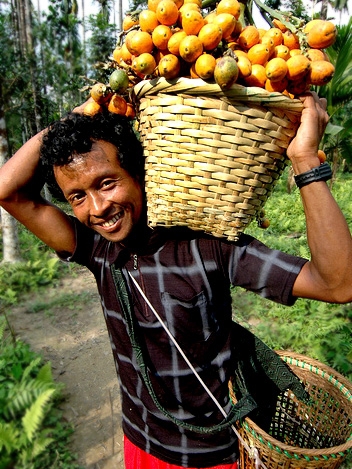




Language
HOW WOULD YOU SEE YOURSELF IF YOU SPOKE MY LANGUAGE?
Language
HOW WOULD YOU SEE YOURSELF IF YOU SPOKE MY LANGUAGE?
LANGUAGE
Language is frequently overlooked in poverty initiatives, but it is a significant factor for most of the world’s poorest communities because they often speak a lesser-known, minority language.
We use language to make sense of the world and to communicate that perspective with others. It’s the social glue that holds societies together. But what if that glue comes unstuck?
What if your community suddenly faced changes and challenges that they hadn’t come across before?
If your community is marginalised, this affects the opportunities that you have and the value that people see in you. Ultimately, it affects the value that you see in yourself.
An integrated Language, Education and Development approach helps communities use their languages in the ways they choose to in the modern world. A community’s language is part of the social and cultural fabric that influences the way they see the world. Valuing it enables the community to navigate change effectively, with their dignity intact.

Education
WHAT WOULD YOU SACRIFICE TO MAKE SURE YOUR KIDS COULD STAY IN SCHOOL?
Education
WHAT WOULD YOU SACRIFICE TO MAKE SURE YOUR KIDS COULD STAY IN SCHOOL?
EDUCATION
Education is widely accepted as one of the key foundations for economic and social development, with good access to quality education a major obstacle for the development of many of the poorest communities.
Parents everywhere want a better future for their children. Many minority language communities don’t have that hope. Children struggle considerably in school if they don’t understand the language being used. And when they aren’t learning, what is the motivation to stay in school?
Over 2300 languages are spoken in Asia, but globally it is calculated that around 40% of the world's population speak languages which receive minimal use in education systems. This fact alone renders minority children, especially girls, at an extreme disadvantage. Of the world’s 60 million out-of-school girls, 70% are from ethnic, religious or linguistic minorities.
An integrated Language, Education and Development approach facilitates effective learning by addressing the barriers that exclude communities from full participation in education. Multilingual education creates space for dialogue across cultures, encourages creativity in the classroom and improves cognitive performance in all domains. Children learn better. Parents are more involved. And communities grow stronger as their culture and values are passed on across generations.

Development
HOW WOULD YOU VOICE YOUR RIGHTS IF YOU SPOKE MY LANGUAGE?
Development
HOW WOULD YOU VOICE YOUR RIGHTS IF YOU SPOKE MY LANGUAGE?
DEVELOPMENT
Development is often conceptualised as changing to something new, something different, something 'other'. But is it possible for communities to embrace a new future without rejecting the past?
In today’s increasingly globalized world change is inevitable, however, it is the poor and vulnerable that are often those negatively affected by these changes. In part this is because they are sidelined from the discussions about what kinds of changes they want to see happen in their communities and how they come about.
How would you feel if all decisions about your community had to be made in another language and culture?
What would you do if you suddenly and unjustly lost your land and livelihood due to economic land concessions or environmental degradation?
An integrated Language, Education and Development approach supports the participation of communities in their own development through the use of their own language, culture and worldview. This strengthens the voice of communities, helping them to adapt to a globalizing world while still maintaining their unique knowledge, sense of belonging and identity.

Learn more about LEAD
INTEGRATING LANGUAGE, EDUCATION AND DEVELOPMENT
Learn more about LEAD
INTEGRATING LANGUAGE, EDUCATION AND DEVELOPMENT
By focusing on these these different areas simultaneously we want to see the following vision (what we call 'LEAD Impact') become a reality:
"Communities in Asia are achieving their education and development goals, while sustaining and celebrating their unique ethnolinguistic identities."
To find out more about what we do, and to help make this vision become a reality, click on one of the links below.



